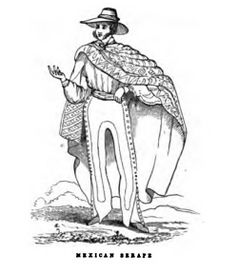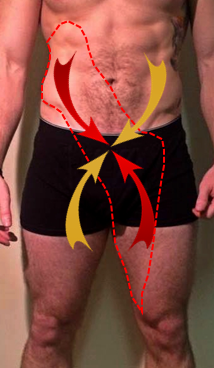Description
The term serape is raised from Mexico, it`s is a form of cloth that looks like a long blanket-like shawl worn by Mexican.
In our body there are a group of muscles is attached together fascially and functionally that form the same shape of the serape .[1]
These muscles that form the serape if they worked together they are going to give you a high force and ballistic motions, such as throwing or kicking.That`s why we call the power that going to be produced by the serape by the term serape effect.
Muscles of the Serape effect[1]
- Ipsilateral Rhomboids
- Ipsilateral Serratus anterior
- Ipsilateral external abdominal obliques
- Contralateral Internal abdominal obliques
- Contralateral adductors
It has shown that serratus anterior has a direct attachment to external abdominal obliques. Therefore during rehabilitation to increase firing to Serratus anterior we enter abdominal and rotation during focusing on serratus anterior exercises as (push up ,bird dog exercise , turn wall punch exercise)[2]
It also has shown that adductors mainly adductor longus has a direct attachment to contralateral external abdominal oblique and ipsilateral internal abdominal obliques. Therefore we use isometric hip adduction to recruit more abdominal muscles during plank exercises [3]
Advantage
- Serape effect will give the athlete a high force and ballistic motions to either upper limb or lower limb due to he adding the trunk muscles and rotation to the upper or lower limbs and also the serape will act as a spring when it`s stretched it will store PE and will convert it into KE during motion, this energy will be transmitted to extremities,
- we can use serape during rehabilitation to get advantage of the attachment of the muscles to each others, so if muscle is weak or inhibited other muscles can facilitate it.
strengthening exercises
- ↑ 1.01.1 Juan CS. The Serape Effect: A Kinesiological Model for Core Training. National Strength & Conditioning Association. April 2003:25(2):73–74.
- ↑ De Araújo R C. Pirauá A L., Beltrão N B., Pitangui A C . Activity of periscapular muscles and its correlation with external oblique during push-up: Does scapular dyskinesis change the electromyographic response?. Journal of Sports Sciences. 2017:36(5):571–577.
- ↑ Kim S Y, Kang M H., Kim E R , Jung I G , Seo E Y, Oh J. Comparison of EMG activity on abdominal muscles during plank exercise with unilateral and bilateral additional isometric hip adduction. Journal of Electromyography and Kinesiology. 2016: 30: 9–14.



